The generative AI application landscape is vast, but when it comes to effectively using generative AI within your healthcare practice, you may find yourself perplexed. We’ve summarized some of the useful applications of generative AI that can benefit you and your business, along with examples to provide as much clarity as possible. Join Ryan Miller, our CEO, as he explains how to prompt like a pro, what pitfalls to avoid, and how to best leverage artificial intelligence.
Video Transcription:
Welcome back, Ryan Miller here with Etna Interactive. And we’re going to talk today about the uses of generative AI, things like Chat GPT or Google’s Bard inside of your practice.
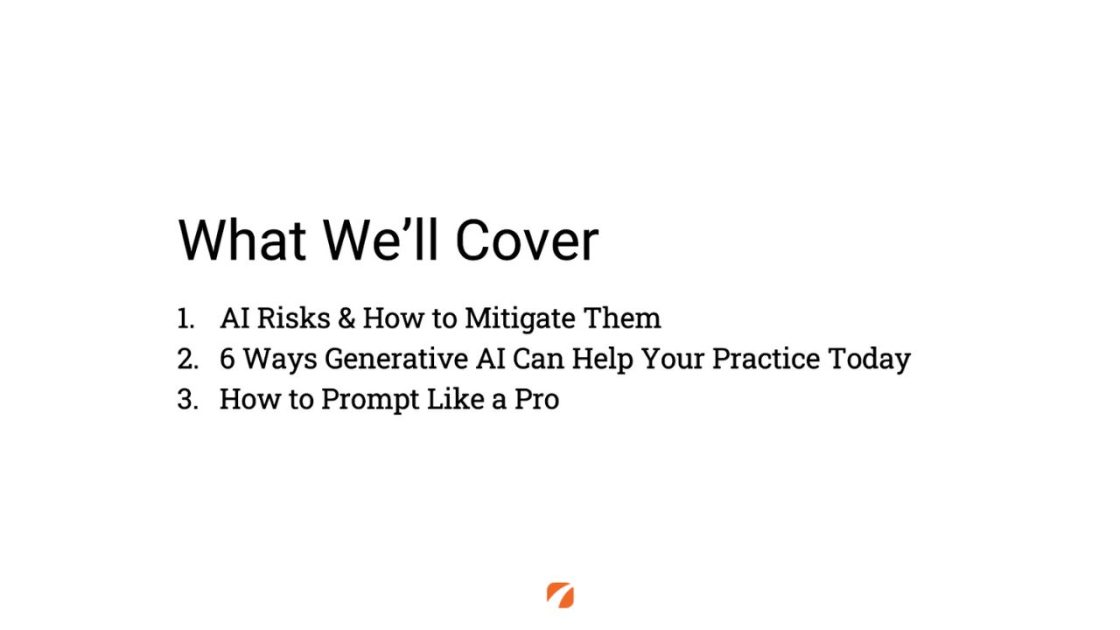
And we’re going to specifically look today at three different things. We’re going to look at some cautions that you might apply when you’re bringing generative AI into the work that you do in your practice. We’ll talk about six different ways to inspire your use of the tools, and then I’ll close with some tips on how to get better at writing prompts that give you great creative outputs.
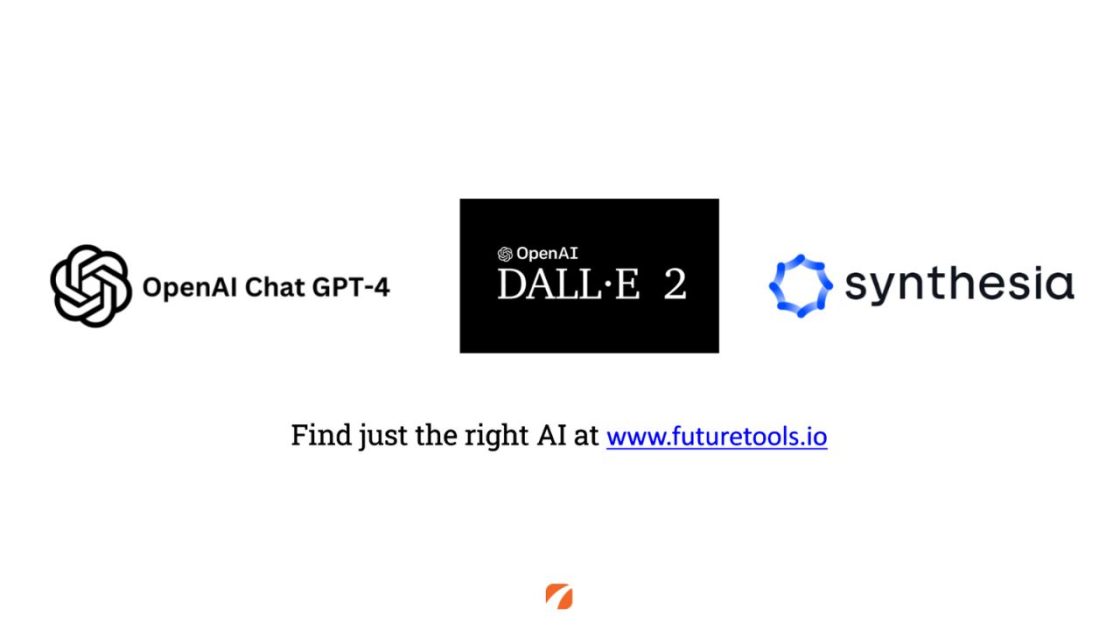
Now, there are lots of types of generative AI. The guidance that we’re going to go through today is mostly focused on generative tools that create text like Chat GPT but know that there are lots of things out there like DALL E 2, which can create original imagery, tools like Synthesia that can actually be used to create AI-generated video avatars. There are lots and lots of AIs; the number’s only proliferating. Check out www.futuretools.io. It’s a great website to help you zero in on some really unique and focused AI tooling that’s out there on the web.
AI Risks and How To Mitigate Them
Let me start with some of the cautionary stuff first to get this out of the way. This is really a conversation that a leader should probably have with members of their team that may be using generative AI in the practice on any given day.
So, the first thing to just be aware of is there are limitations on some of the free tools. And if you’re going to build this into your daily workflow, requiring or expecting members of your team to gain efficiency through it, you might need to subscribe to the for-fee versions of some of the tools to gain unfettered access.
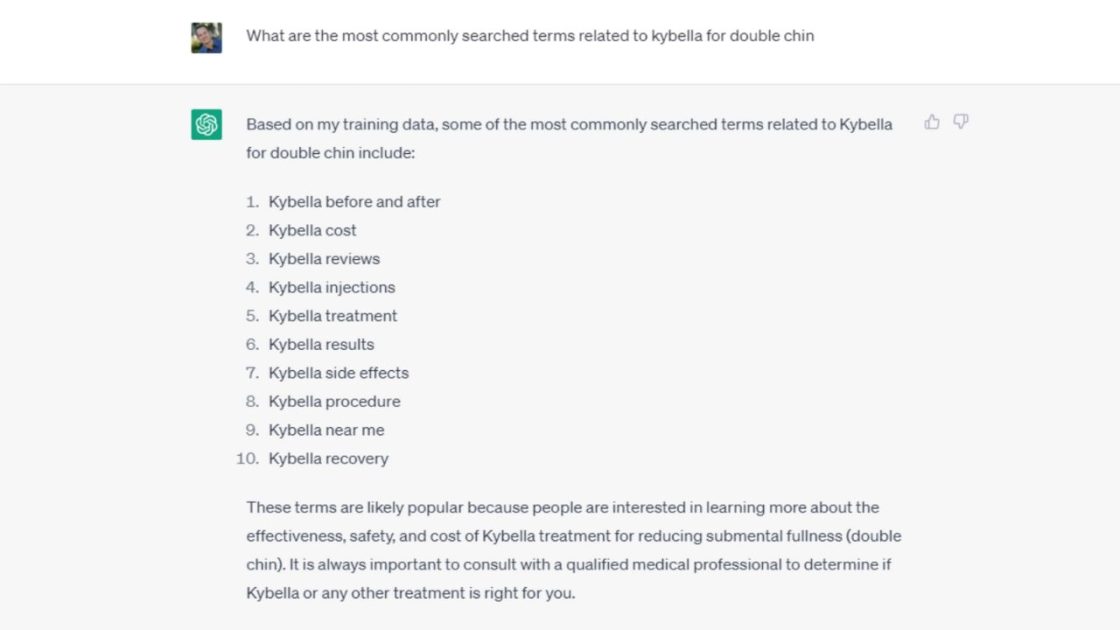
Additionally, let me give you a real-world case study here of some keyword research that I did. So, I asked Chat GPT, in this particular case, to give me examples of commonly searched terms related to KYBELLA® for double chin.
Now, the example, if you look at the ten results on your screen that come back, they all start with the word KYBELLA. Now, the risk that we have today is if someone is not experienced enough to ask the right questions or doesn’t have an understanding of what the data set should look like. This could look like a very acceptable result.
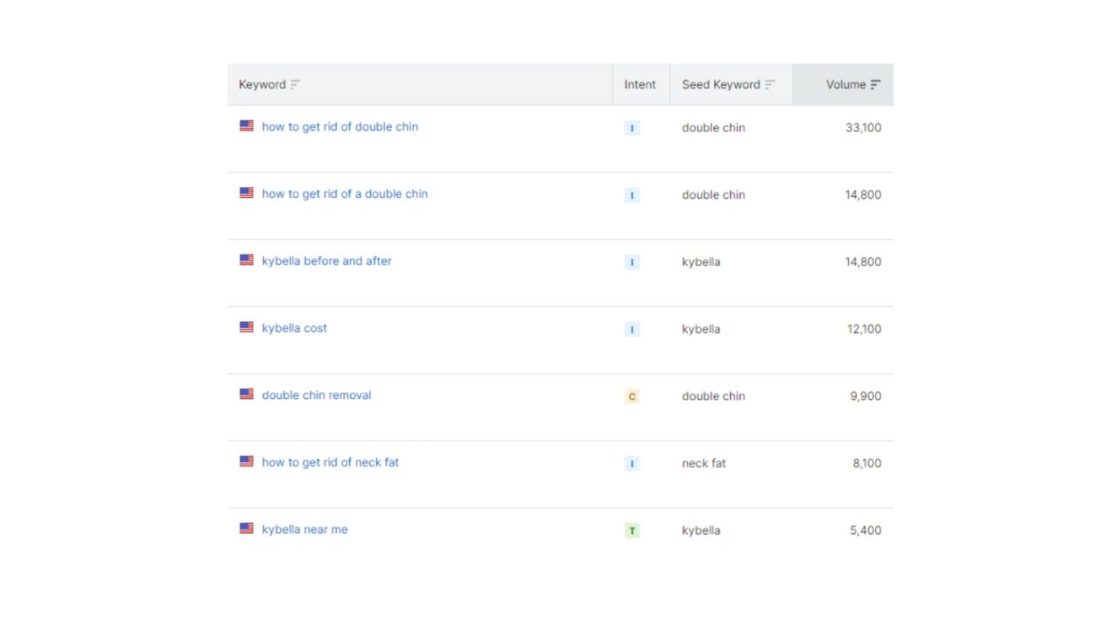
The reality is, based on both our years of experience and using the right tooling, this particular data set here is extracted from a search engine optimization toolset called SEMRush. By expanding my keyword research, knowing that there should be some queries out there that don’t reference the word KYBELLA that indicate a patient’s interest in having submental fat reduction, I’m able to find a better data set. And in fact, the most popular keyword on this list, “how to get rid of double chin” is about three times more popular than the most popular search that contains the KYBELLA brand name.
So, I would have missed a massive portion of the market if I had only focused my search engine optimization on that initial result set that came back from Chat GPT.
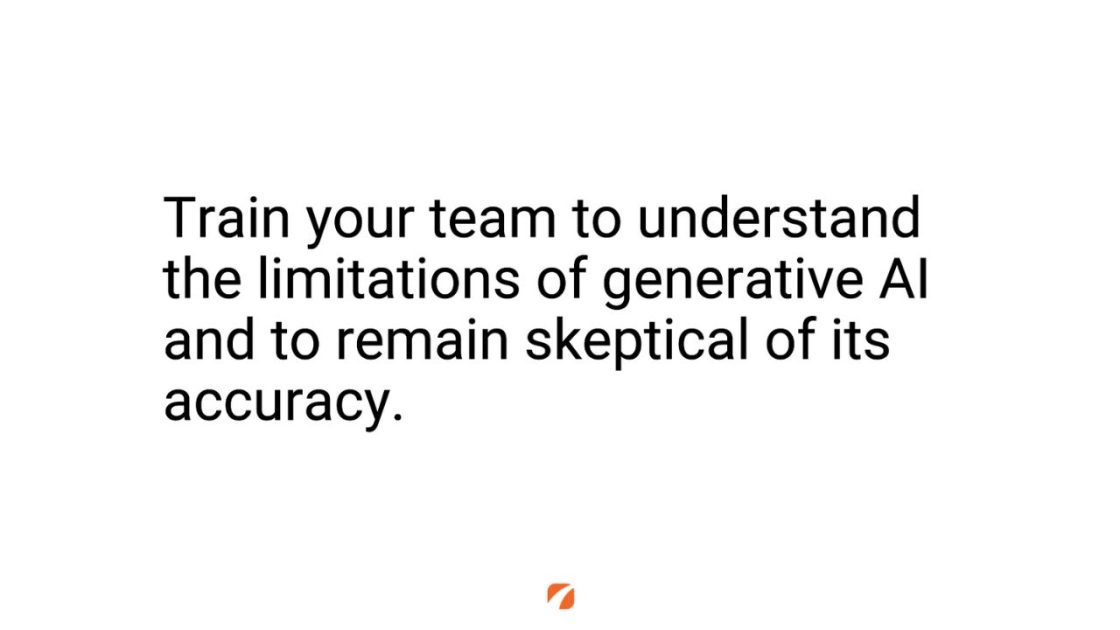
So, what’s important as a leader for you to convey to your team are really two things. They need to understand the limitations, the biases that are inherent either in how we pose our questions or in the data that are available to the AI. In addition to that, we have to maintain a healthy skepticism of the results that we get back and not always accept them at face value.
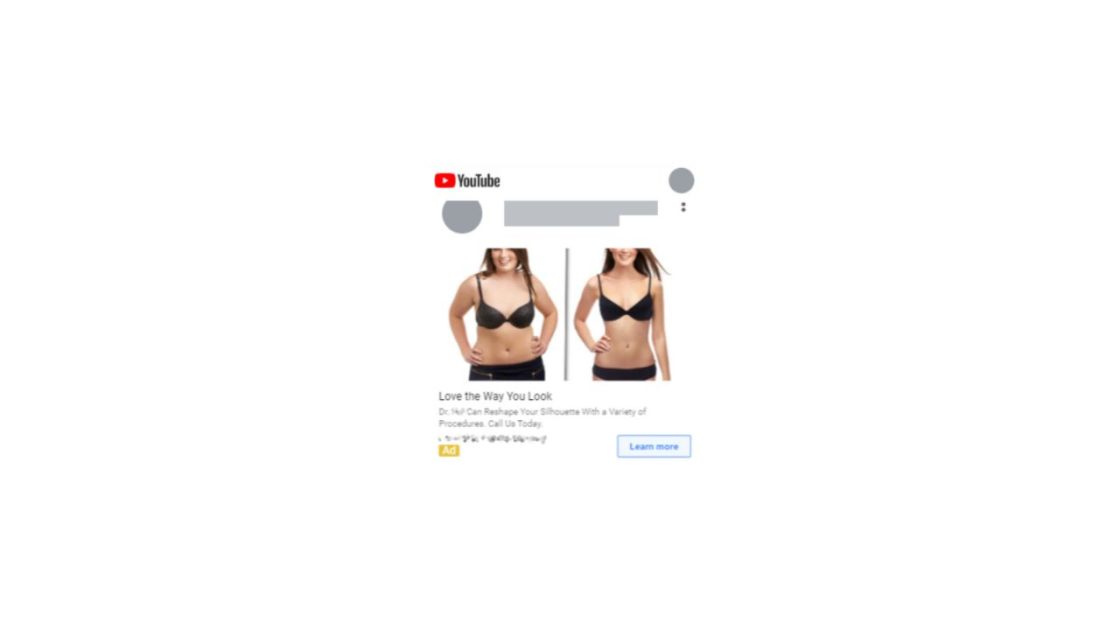
There are other places we need to be concerned where AIs are entering workflows that we may need to think a little bit harder about. In this particular case, Google Ads offers a tool that will automatically generate images to pair with advertisements on platforms. In this case, like YouTube.
So, in this particular example here, the generative AI had suggested that we show this image along with an advertisement for a board-certified plastic surgeon. The problem? That’s not a real before and after, and there’s no disclosure that it is, in fact, an AI-generated model image. This technically would qualify as false, fraudulent, or misleading advertising and would not be legal in any of the 50 United States or all across Canada.
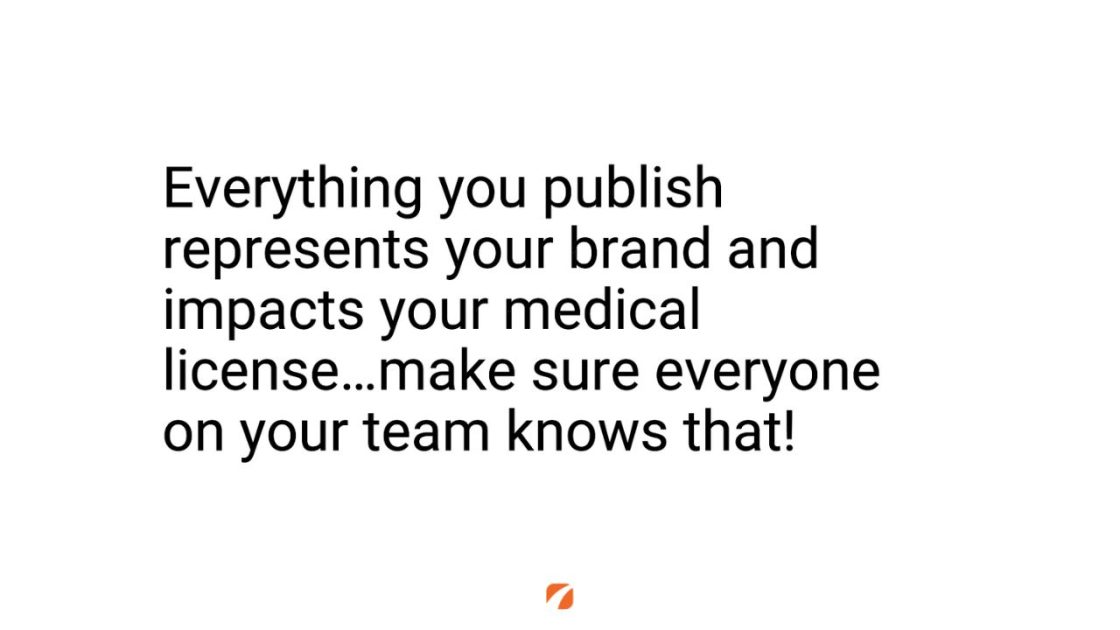
So, recognize two things: As generative AI is creating content for you, it’s a reflection of your brand, and the voice, the tone, the style to reflect who you are. But more importantly, everything that you publish is a direct reflection and has an impact on your medical licensure. And we need to abide by medical laws, codes, and guidelines to make sure that the use of the tooling doesn’t actually get you in trouble.
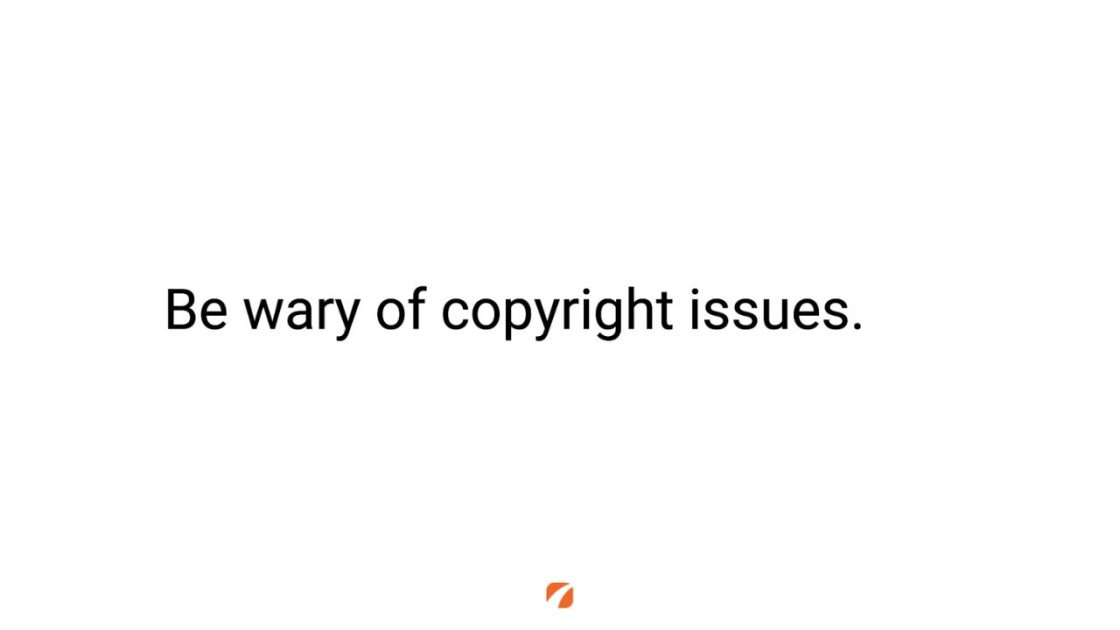
And this last concern for me is a very small one. Just recognize that the jury is technically still out on whether or not you can own copyright to all of the content that’s created by generative AI. And well, if the stakes are really high, you might want to create it by hand.
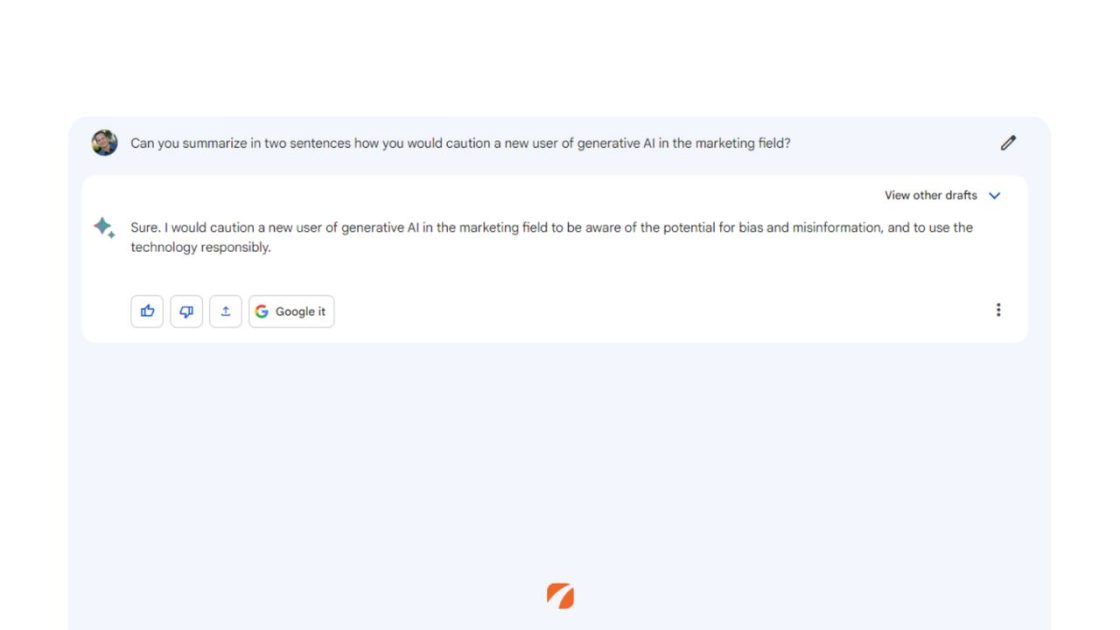
So, at the end here, I asked for Bard, in this case, to summarize for me any advice that it would give in terms of cautioning a new user of generative AI. And it really captures everything here, I think in two sentences very clearly.
Number one, we need to be aware of both the potential biases and the possibility of misinformation coming out of the results from generative AI. And number two, we need to use the tooling responsibly.
Six Ways Generative AI Can Help Your Practice Today
Let’s talk about using the tooling, because this is the part that I think you’re really going to get excited about.
![(Accelerate Research
1. Generate a list of keywords, FAQs or topic clusters.
2. Extract themes from large sets of data.
3. Abbreviate a long article.
"Analyze the patient reviews pasted below and extract prevalent keywords and themes. List the most common themes first. I'm specifically interested in themes, positive or negative, related to service. [paste 100+ reviews]"
Top positive service theme: Lauren)
Open AI logo](https://www.etnainteractive.com/content/uploads/34-1-1120x630.jpg)
My first and favorite way to use generative AI is specifically to accelerate my research. To give me inspiration keywords that I can then go use in other tooling, to get ideas for FAQs, or topic clusters that can inspire my writing. I can use it to extract themes from large sets of data and to take a big article and abbreviate to its most salient points.
Let me give you an example of that second point here. I actually took about 140 online reviews for one of our client practices. And, in anticipation that I would be participating in a staff meeting, I asked it to synthesize down some important customer service themes that we could use to inspire a conversation about improving customer service in the practice. I asked it to find both good and bad themes and summarize them back to me.
Surprisingly, while there were some great ideas in there about both good and bad things happening in the practice, one of the best things that emerged in the data set was Lauren! A member of the team, the patient care coordinator, who is clearly loved because she was mentioned more than anything else in comments about service from this particular client.
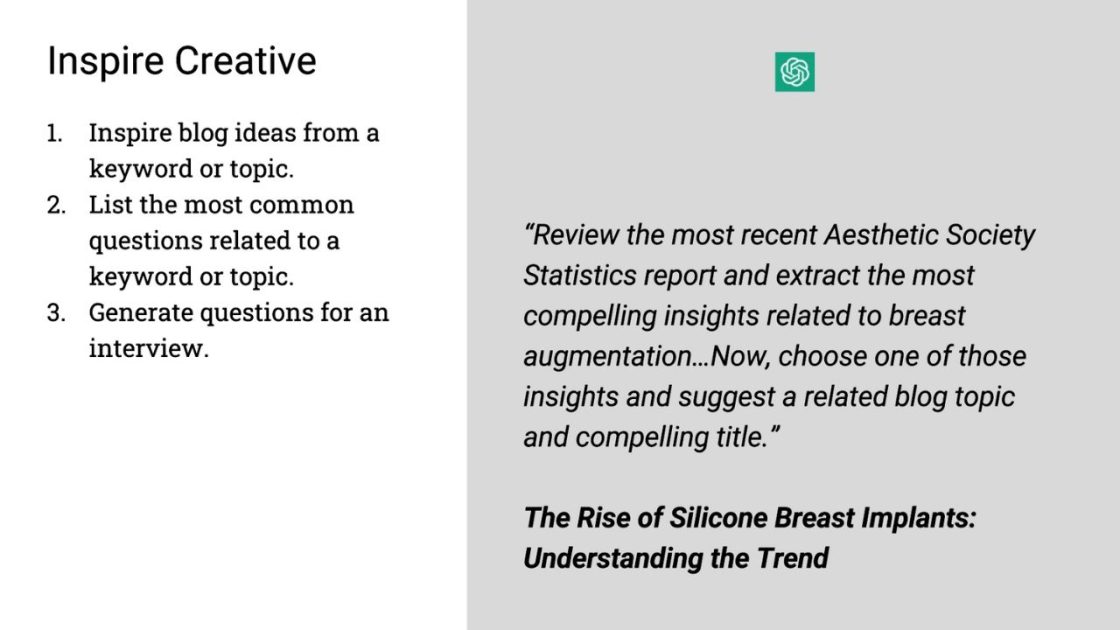
It can inspire our creative, it can give you blog ideas from a single keyword or topic, it can list the most common questions that come up related to one of those keywords or procedures. Additionally, it can generate questions for an interview. Say you’re a social media specialist who is going to be stepping into the room with a provider and a patient who’s contemplating a mommy makeover. By loading in just a few demographic details about that patient and what you’re hoping to take away from the interview, you can get a great question set.
But in this specific example, here, I wanted an idea for a blog, so I asked Chat GPT to go out and review the most recent aesthetic society statistics. It immediately came back to me and said, “hey, I only have data dating to 2019,” which was good to know the limitations of its data there. And to extract some compelling insights related to breast augmentation. It gave me a host of insights. I asked it to then, in a subsequent post, to select just one insight and suggest a related blog topic. And it came back with: The Rise of Silicone Breast Implants: Understanding the Trend. Which I thought would be a great thing to explore and write about.
![(Craft Tight Text
1. Craft titles, abstracts or subject lines from a body of text.
2. Generate ad copy.
3. Write social media posts/captions.
"Read the blog copy that follows and suggest 5 compelling titles (at least one should be humorous): [pasted post about maintaining perky breasts]"
Keeping "The Girls" Up: Practical Tips for Perkier Breasts)
Open AI logo](https://www.etnainteractive.com/content/uploads/36-1-1120x630.jpg)
It can also craft nice, tight text. As someone who can be, you might be able to tell from this video, a little bit verbose, it’s great to go in there and have it synthesize or shorten an email, to craft a title, an abstract, or a subject line. It can create nice tight ad copy, they can write social media posts for me.
So, in this particular example here, what I asked Chat GPT to do for me was to read the blog copy that follows, and I actually pasted the full blog post that happened to be about perky breasts, or maintaining perky breasts, and suggest five compelling titles. And I just to be a little cheeky, I said, hey, at least one of them should be funny. The funny one it came up with was: Keeping “The Girls” Up: Practical Tips for Perkier Breasts. And yeah, it’s a little bit cheeky, but it’s something that gave me a little bit of a laugh.
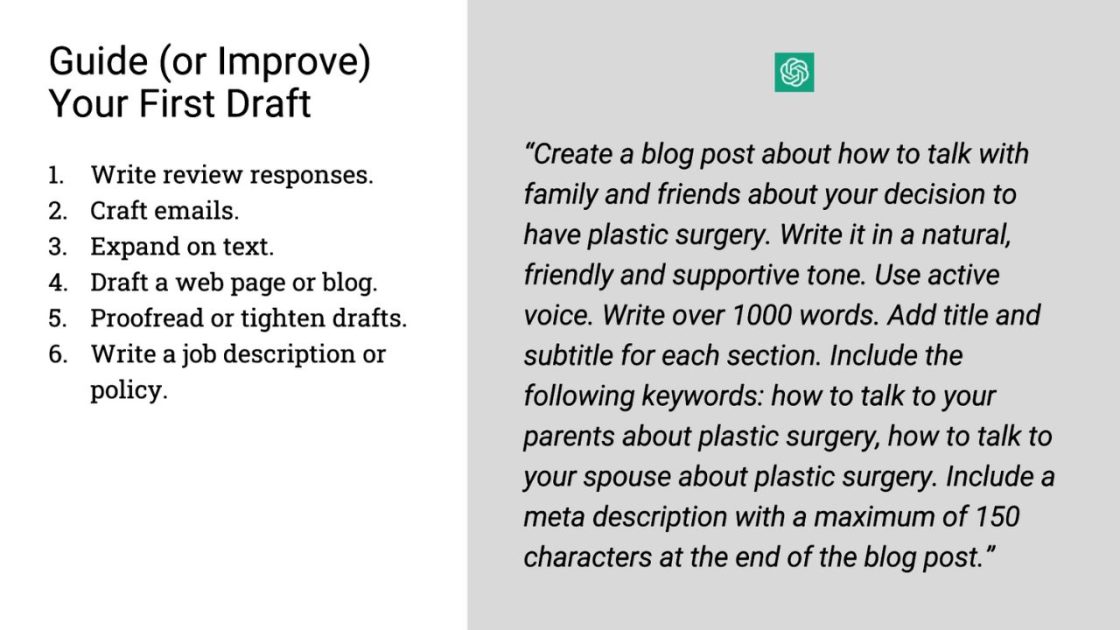
So, let’s talk about how it can also guide, or actually improve your first draft of almost everything. If you get a lot of reviews and you find it hard to be original in responding to them, it can help you write review responses — remember there needs to be somebody in the room who knows how to ensure that reply is HIPAA compliant.
It can help you craft an email in response to a patient or a colleague. It can expand on text, the exact opposite direction of what we’re just talking about. It can take a few sentences about a topic, and it can elaborate on them. And it can write whole new web pages or blog posts. It can also proofread or tighten up your drafts for you, and you can use it to do things like write job descriptions or office policies. I’m not going to make you read everything on the screen here, but I am going to break this down in just a second when we talk about crafting great prompts.
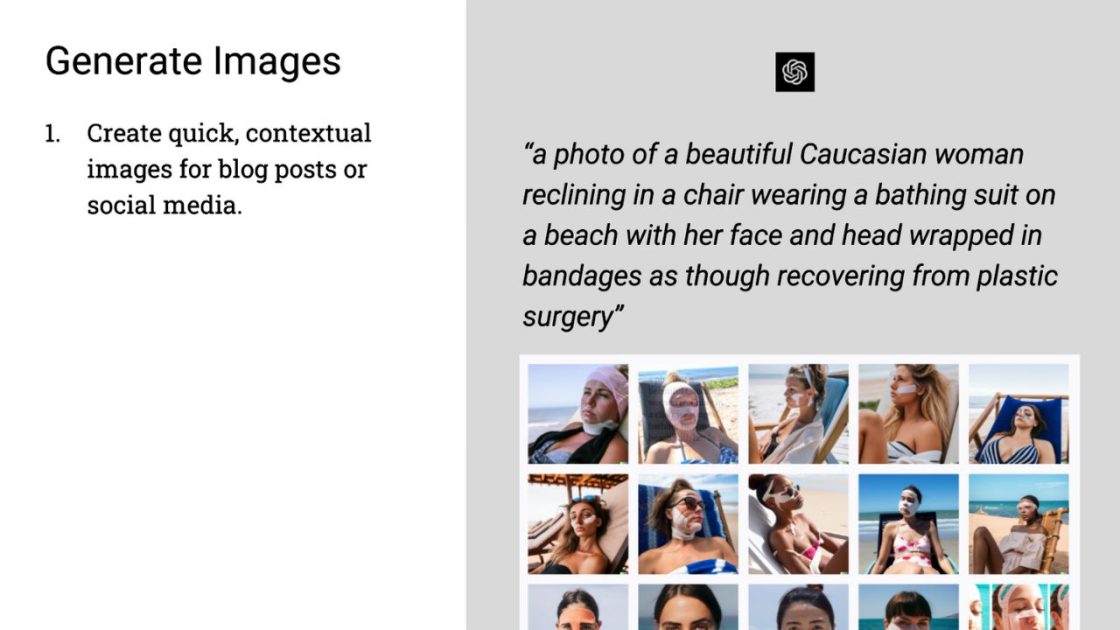
As I mentioned at the very beginning of this, it can generate original imagery. So, use a quick contextual image. I think these are usually good for blog posts or social media if you’re going to do it at all. I asked DALL-E 2 for a photo of a beautiful Caucasian woman reclining in a chair wearing a bathing suit on a beach with her face and head wrapped in bandages as though she had just had plastic surgery.
Now, I am not exactly sure what surgical procedures some of these people might have had for the placement of their bandages, but there are at least one or two images in here that would certainly catch somebody’s eye as the intro image on a blog post about, say medical tourism.
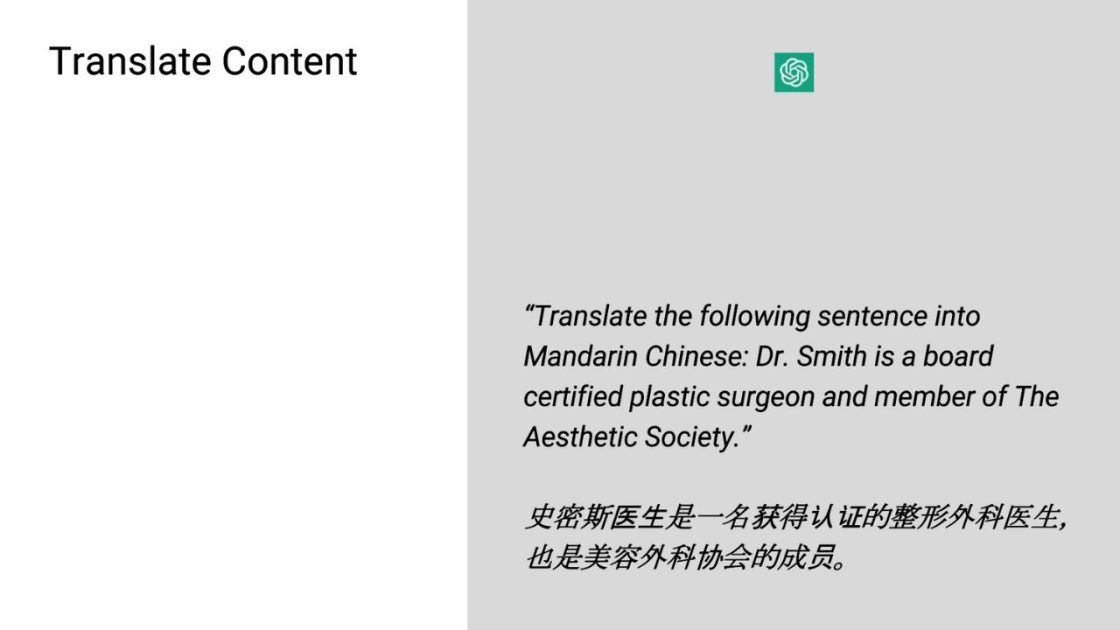
So, it can also be a great translation tool. Here, Chat GPT changes this one sentence from English into Mandarin Chinese. I’m going to have to trust that Chat GPT actually got this right. If anybody actually happens to read Mandarin Chinese and wants to check me on this and reply to the comments on the blog post or on YouTube, I’d be grateful.
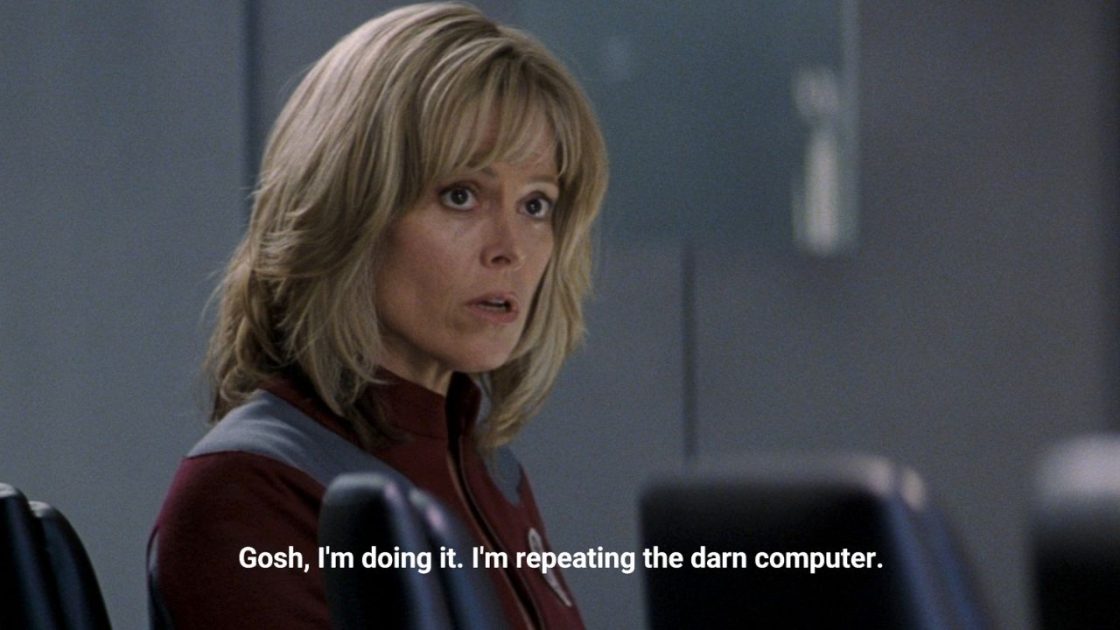
How To Prompt Like a Pro
All right, so let’s talk about how to prompt like a pro. I am a giant nerd at heart, and some of you may have recognized right away this particular image here. This is Sigourney Weaver. I think it’s the only time she’s ever been a blonde in a movie. And it is the movie, Galaxy Quest.
It’s a parody of some of the big science fiction genre TV shows and movies that are out there. And in the movie, she has one job, which is to translate what the humans are saying to the computer and then to repeat what the computer says back to the crew.
Now it’s a little bit prescient because it’s a really critical skill today. Probably one of the most important skills that somebody entering the workforce can develop. Which is learning how to talk to the AI, how to extract from it the answers, the creative content that we want. And there is definitely an art to it.
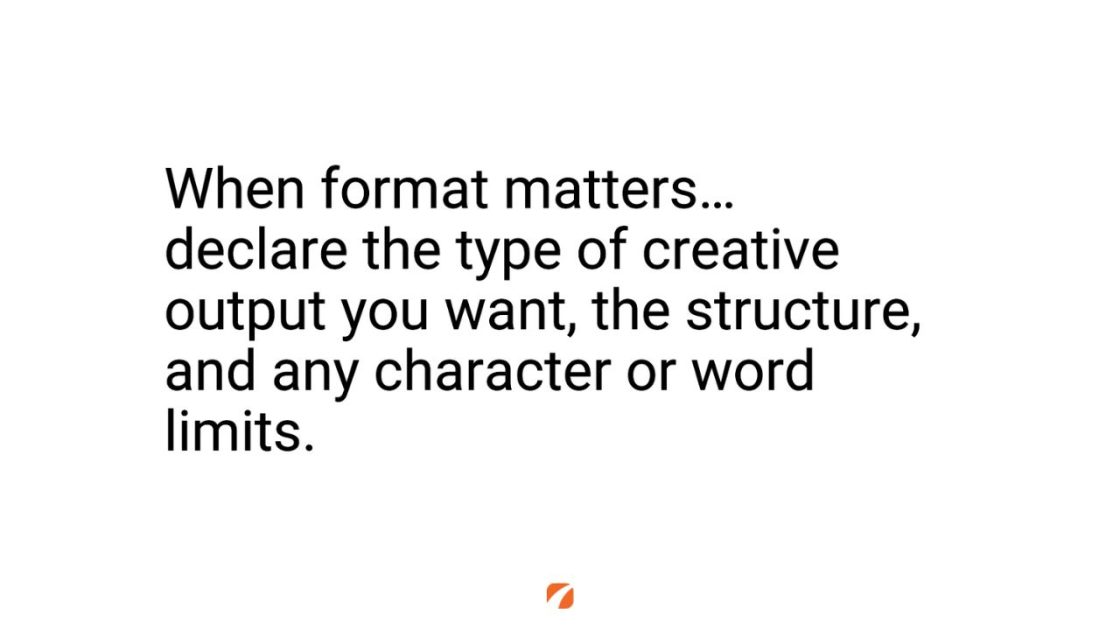
So, if format matters, the prompt that you use for the AI needs to declare the type of material that you’re trying to output, the structure that you want it to take, and things like character or word limits that are going to guide how long that particular piece of creative needs to be.
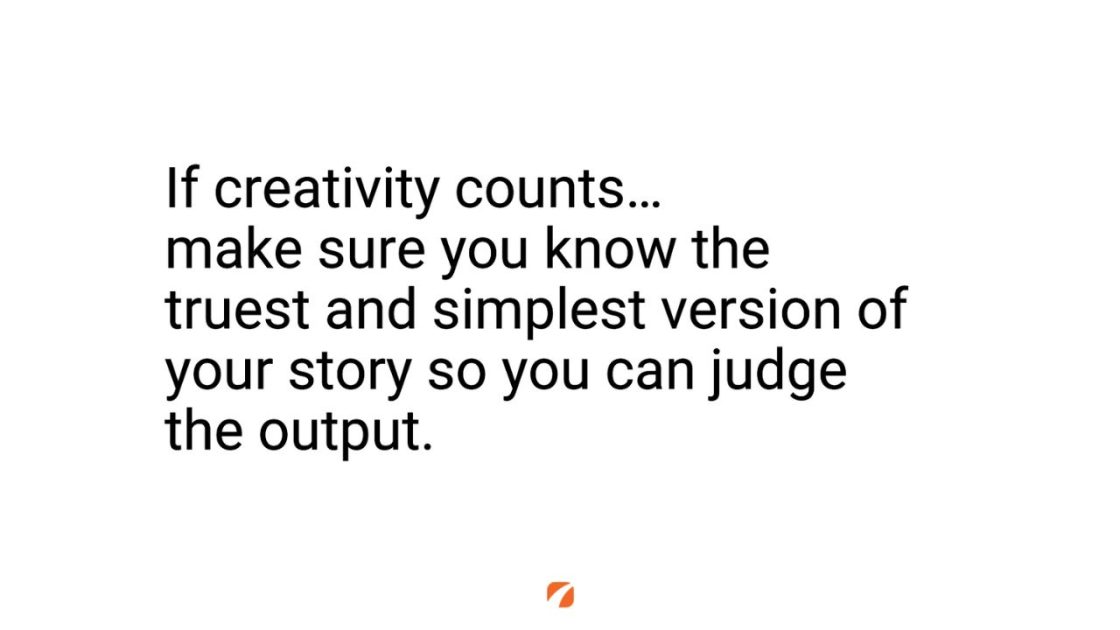
And I’m going to give you an example here at the end that sort of breaks all of these tips down. If creativity counts, what’s important, in my experience, is you need to know, you have to have a clear vision of what it is you’re trying to say, demonstrate, train, or otherwise achieve because sometimes you’re going to get creative output back that simply takes you in a new direction that is not productive. And you need to have a clear enough sense of what you were trying to do to begin with, to judge the output and course correct.
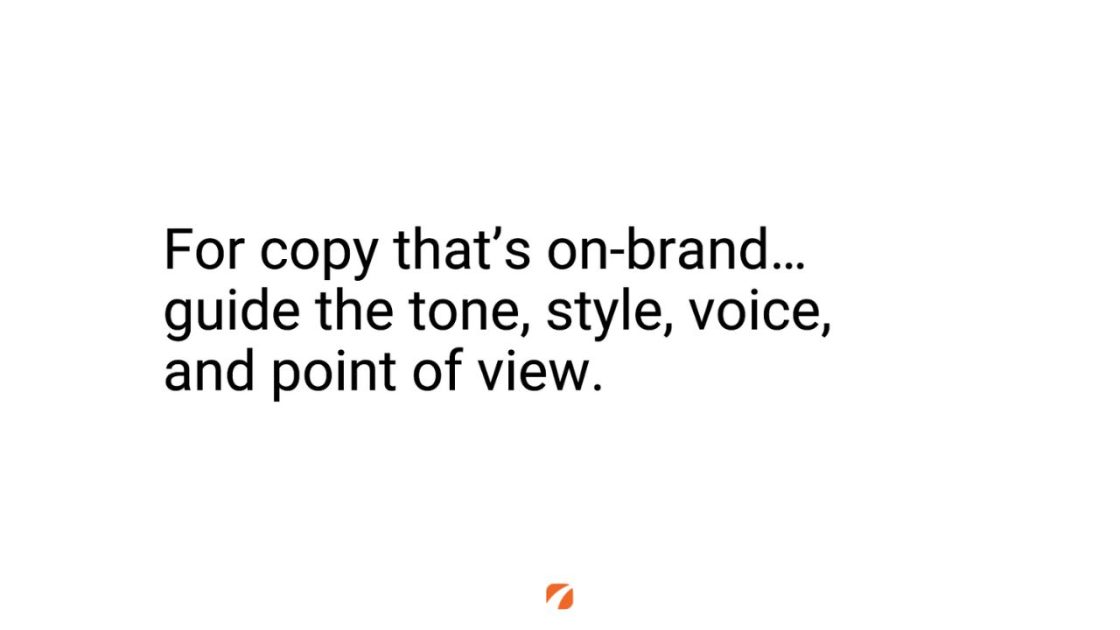
For copy that needs to be on your brand, guide the tone, the style, the voice, and the point of view so you get exactly what you need.
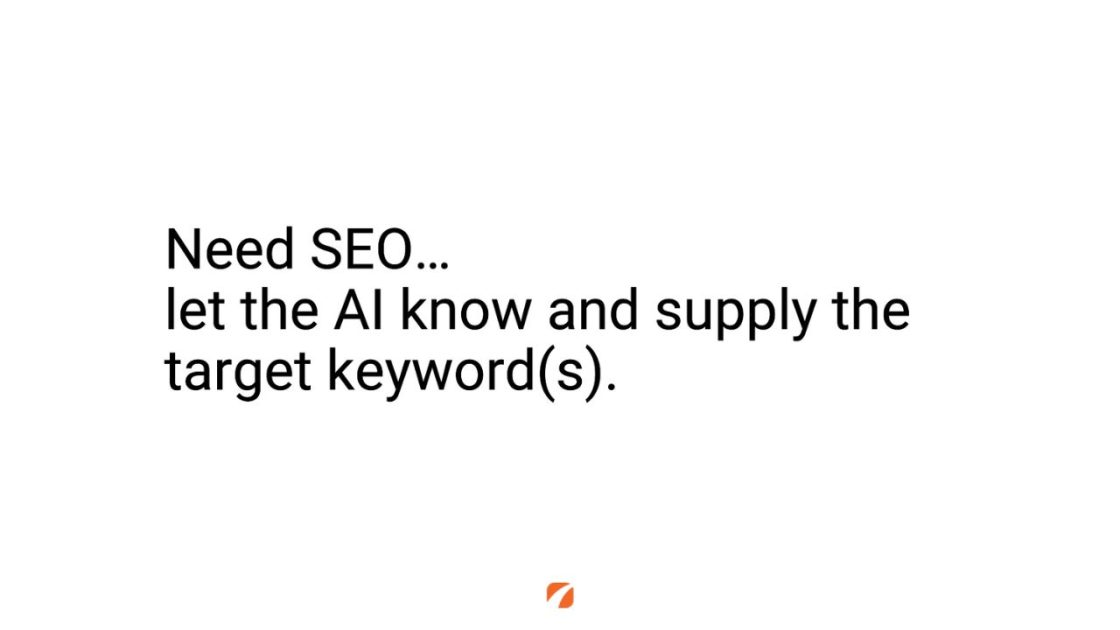
If it needs to rank, if it needs search engine optimization, well, then you need to provide the AI with the list of keywords that it can use to inform that particular piece of copywriting.
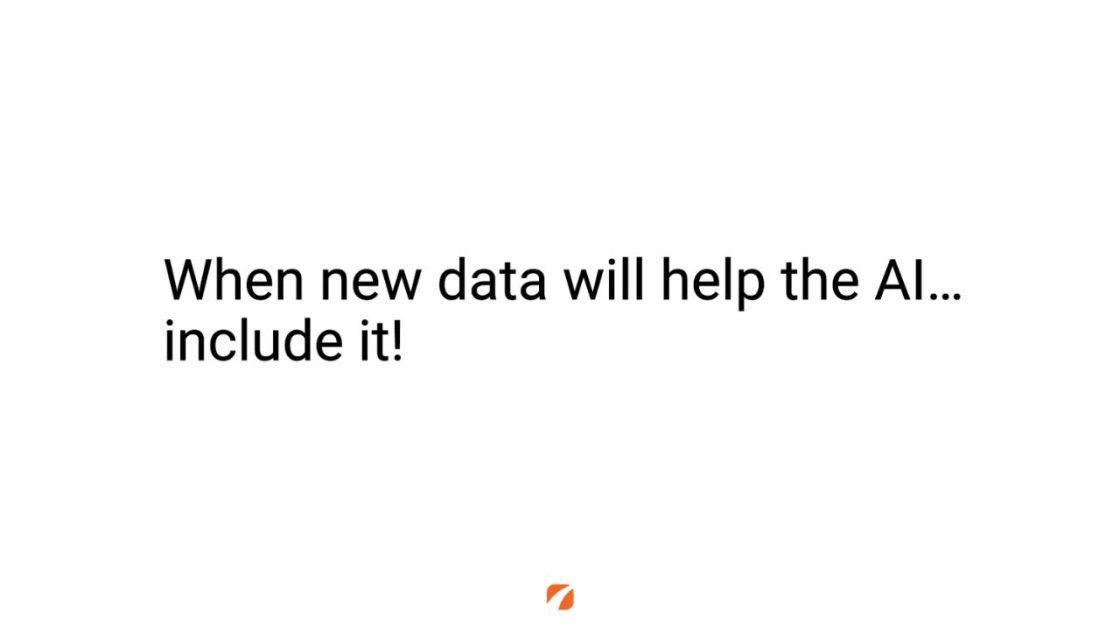
If there’s data that you think would actually help the AI do the job better, give the AI the data! You can copy and paste it in, and with certain AI tooling, you can actually link directly to things like web pages where it will find source information.
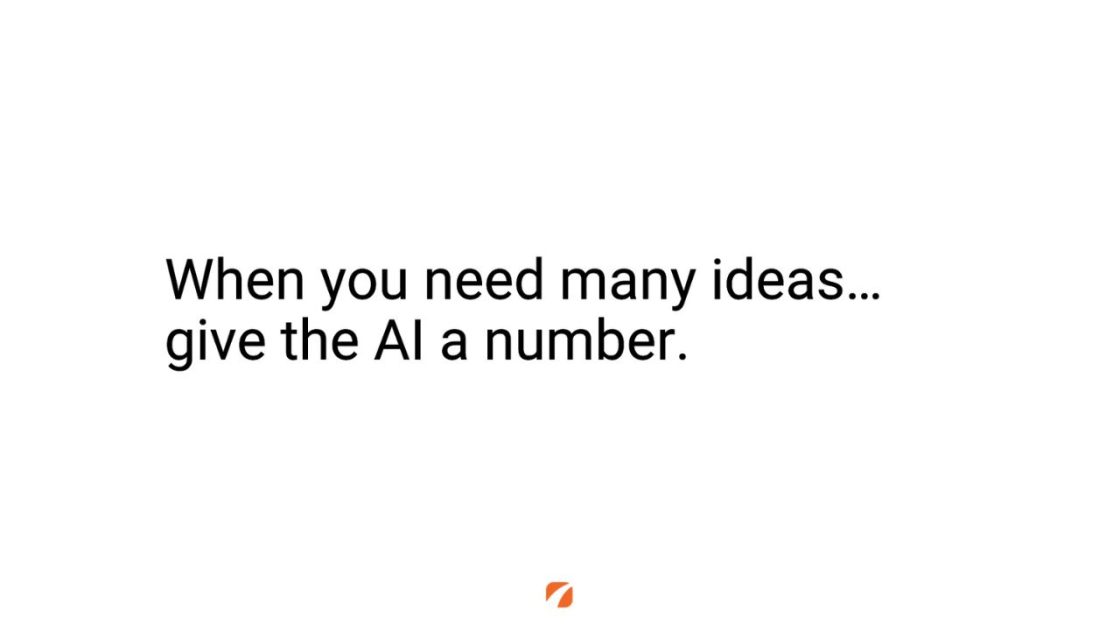
If you need many ideas, just name the number. If you want five blog titles, if you want three email subject lines, give it that number, and that will give you the opportunity to pick and choose from the best of the ideas that are shared from the generative AI.
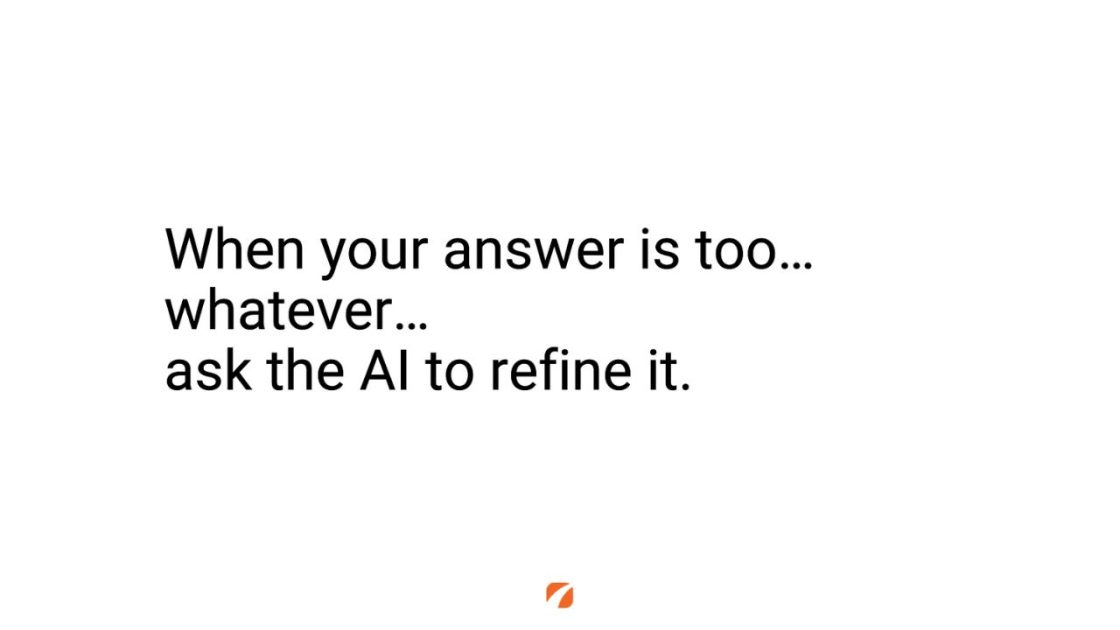
And I think this is probably the most important skill that any member of your team that is using any generative AI can develop. Which is simply asking for something, well, if the answer you get back is too long or it’s too short, it’s too formal, or too informal. Whatever it is, that’s too something, just ask the AI to recast it or refine it, moving in a new direction.
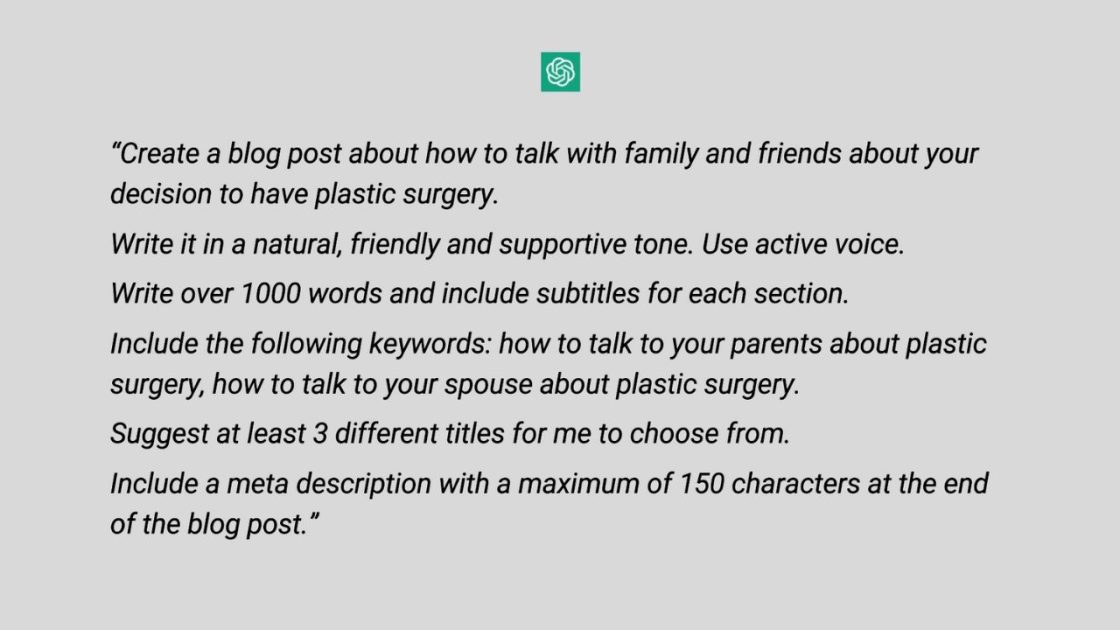
So, let me give an example that sort of summarizes all these things except for that last one here. This is that big dense example of a prompt that I put on the screen when I was talking about creating a blog post.
So, I asked to create a blog post about how to talk with family and friends about a decision to have plastic surgery. So, in that, I gave it structure and topic. Then, I went a little farther and gave it direction on tone and style. A natural, friendly, supportive tone written in the active voice.
More structural cues here, I need more than 1,000 words, and I want it to break up clear subtitles across the entire document. It should include the following keywords, so this is my queuing for search engine optimization. I want numerical options for creative titling, so give me three different titles that I can choose from and play around with and edit. And by the way, I’m going to need what’s called the meta description. This is information that gets loaded behind the scenes in the page with a maximum of 150 characters. Put that at the end of the blog post.
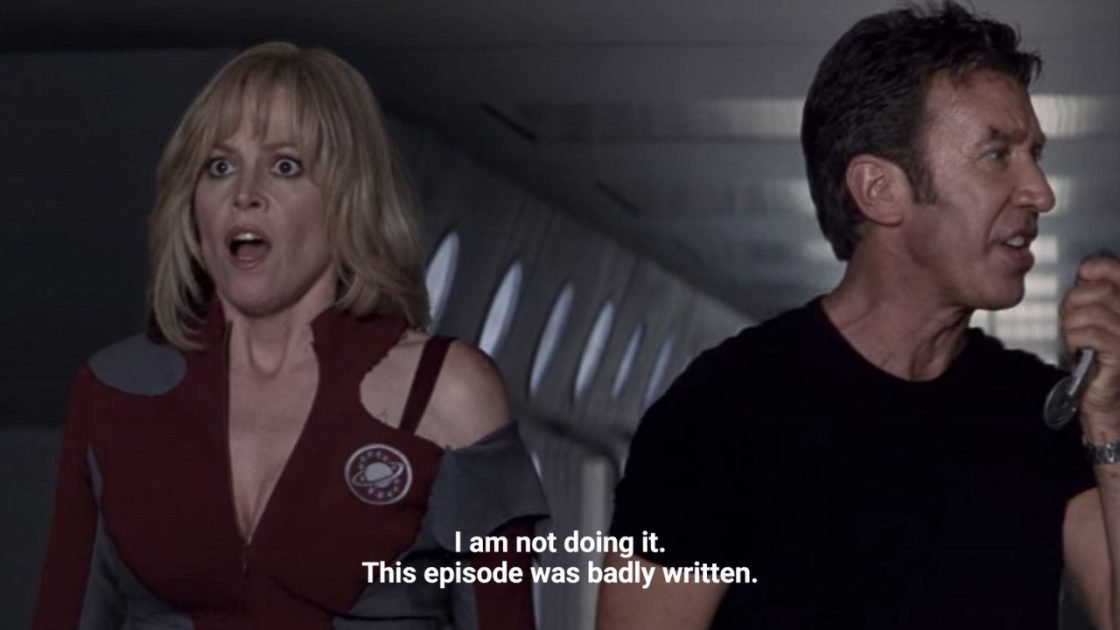
All of these things are required to get enough to really arrive at a useful piece of creative. Now, there’s a great line at the end of the movie, “I’m not doing it. This episode was badly written,” where they have to go through a ridiculous obstacle course at the conclusion of the scene.
So, if you’re feeling the resistance, if you just don’t want to do it, our advice to you is dive in. The only way you’re ever going to get good at using generative AI is by using generative AI.
Use some of the tips that we share just above to refine the way that you approach your prompt creation, and you’re going to be a star at it.
So, if I didn’t answer your question, if you have some feedback or an observation, go ahead and contact us. We’d love to hear your feedback.


This was a great video. I am not using AI professionally yet. I’m conflicted…
Dr. Horton, I believe the only way you can navigate through the conflict is through personal trial. You’ll be able to guide your team once you have some experience and a vision of the ways it can help make the practice more efficient. Here’s my advice. Pick a complex message you might need to convey to your patients, like notice of a price change or the addition of a new provider, and work with ChatGPT or Bard to help craft that announcement. No matter how satisfied you are with the first draft, prompt the AI to refine it at least twice so you can understand how quickly you can approach a working draft. I think that conflict will melt away! ~Ryan